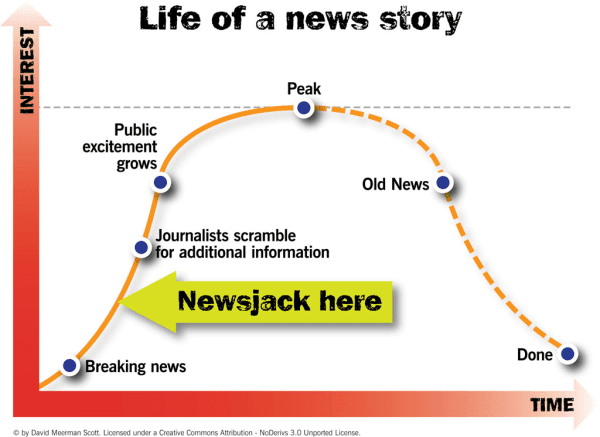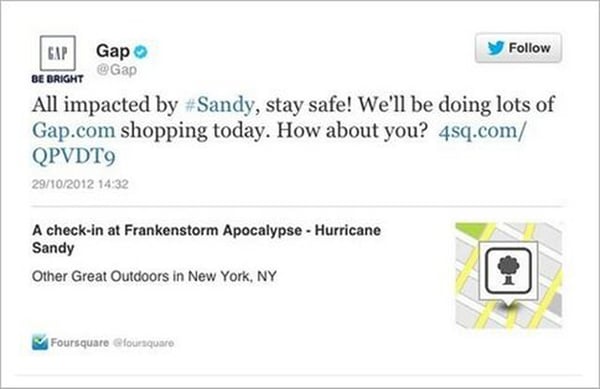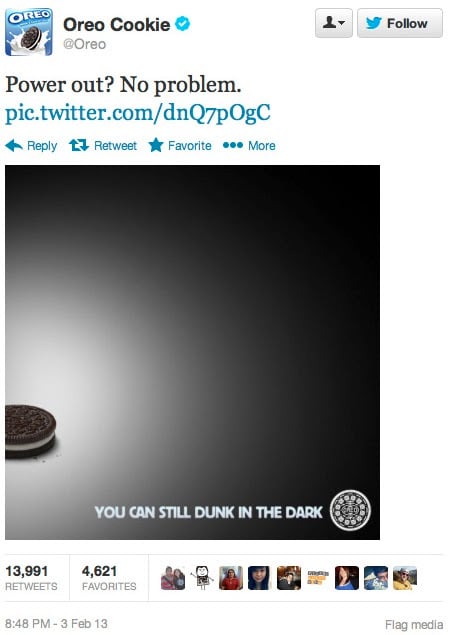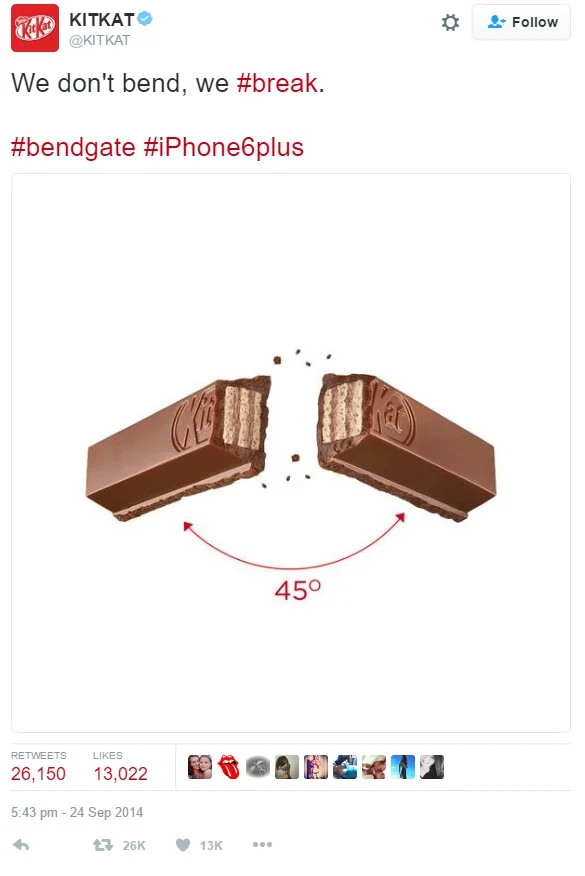
If there ever was a single most effective-yet-dangerous technique to generate instant brand awareness for your business, it's newsjacking.
Done well, your brand’s message would be perceived positively by a wide audience, generating extensive press coverage and social media engagement. Conversely, if done wrong, it can be perceived as forced, awkward, or even offensive marketing that brings your business in the negative limelight.
In this mini-guide, let’s take a detailed look at the what, why, and how of newsjacking, with successful examples of newsjacking from top brands.
According to David Meerman Scott, the international best-selling author of Newsjacking: How to Inject Your Ideas into a Breaking News Story and Generate Tonnes of Media Coverage, newsjacking is a form of real-time branded communication wherein you inject your ideas into a breaking news story at just the right time for it to spread and reach a massive audience.
In the bell-shaped curve shown below, the idea is to inject your content in the news before journalists start scrambling for information and people’s excitement starts burgeoning. Doing so allows your brand to become a part of the story as it develops into trending news that floods social media platforms and tops Google search results.

In the era of instant online communication and real-time news updates, Scott emphasizes that the old PR model of sending out elaborate press releases or pitches isn’t optimal. Today, you can create timely blog and/or social media posts to jump on the news story at the right moment to generate tons of free media coverage (and backlinks) for your business.
While you can view newsjacking as a relatively modern PR technique, for many brands, it has become an important part of their inbound marketing strategy. Now let’s see how you can correctly incorporate newsjacking in your marketing strategy.
As already mentioned, if you want to hijack the news for a quick and exponential increase in brand awareness, you must do it right – every single time. Because even if you unintentionally put out newsworthy content that’s deemed insensitive or offensive by the masses, your business’s reputation can take a serious hit.
So, always keep the following guidelines in mind to master the art of newsjacking for marketing your business.
The popularity of a news story shoots up and dies down pretty fast, so the key to successful newsjacking is to be on your toes – ready to act quickly. You can’t afford to waste time in obtaining content approvals from senior executives as a delay can drastically reduce the reach of your message. So, create a plan of action for pre-approvals beforehand to ensure that whenever it’s time to ride the wave, there are no delays.
Plus, you can’t always be watching the news, so you need to set up news alerts. To do that, simply go to Google Alerts, enter the topic you want to be notified about, adjust the settings (such as how often you want notifications, the source of the news, language, etc.) by clicking on “Show Options," and then hit “Create Alert”.

Now you’ll receive timely email notifications every time there’s breaking news about the topic.
You can also view trending topics around the world by frequently visiting Google Trends and monitoring trending stories about topics relevant to your business.

Likewise, you can (and should) monitor the trending stuff on Twitter so you don’t miss out on relevant news that you can capitalize on.
While every piece of relevant news deserves your attention, not all news merits action. That is, almost every day you’ll find trending topics on the social web that may be somewhat relevant to your business, but you don’t necessarily need to create quick content for those topics.
Make sure to act promptly only if the topic has a decent search volume with keywords that are relevant to your business. Don’t go out of the way and post content that’s unrelated to your brand just for the sake of landing the spotlight, as it will most likely be seen as forced and unnecessary.
Sure, successful newsjacking is largely about timing, but you need to know what you’re talking about, especially if that content is going to be viewed by hundreds of thousands of people.
So, do your homework: read, research, and know all of the facts before attempting to newsjack a topic you’re not totally familiar with.
Chances are, you’re not the only one in your industry trying to capitalize on a piece of breaking news. Your competitors are doing the same.
So, you want to differentiate your brand from the crowd by being more creative with your message. For example, depending on the topic of the news, you can use memes or maybe even show some self-deprecating sense of humor on social media. Doing so may further add to the potential of going viral across the internet. Also, to enhance reach, use trending hashtags alongside your own branded hashtags, if you have any.
With newsjacking, the last thing you want is to have your brand be publicly chastised for being insensitive or exploitative.
As a rule of thumb, avoid commenting on things like natural disasters, national conflicts, and other misfortune or controversial events. At most, you may send out a little tweet showing your sincere condolences without any brand-related promotions.
For instance, in 2012, Gap decided to newsjack a natural disaster...which, let’s just say, was counterproductive.

Just remember: when in doubt, don’t send it out. It’s better to pass an opportunity instead of risking a huge backfire.
It’s worth mentioning again that it’s crucial to share your content while the story is still developing. That is, in that bell-shaped curve referenced earlier, make sure you get your message out before the interest peaks, ideally when journalists are still hunting for more details. Only then does your brand stand a chance to reach the full potential of newsjacking.
If the audience’s interest in the story is past the peak point (“old news”), it’s best to not bother. Because as a business, arriving late to the party won’t do you any good. It would probably make your brand look a bit desperate.
Just like with any marketing or PR effort, you must track the effectiveness of your newsjacking efforts to continually improve future results. As your newsjacking content is likely based on a social media platform, you can easily track audience engagement (likes, comments, shares, retweets, etc.) for your content on the platform itself.
So, for example, if it’s a branded tweet on a developing news story, you can use Twitter Analytics to accurately measure the impact of your tweet in terms of engagement and follower growth.
Also, make sure your website has the capacity to handle the sudden surge of traffic that may result from successful newsjacking. You don’t want to spoil the party with a sluggish website just because your hosting plan is inadequate, for example.
We saw how the well-known apparel brand Gap went horribly wrong with their attempt to newsjack a natural disaster. Now, let’s take a look at three examples of brands nailing the art of newsjacking, for you to take some inspiration from:
One simple tweet from Oreo way back in 2013 was what started the social media newsjacking trend. As you probably know, the power at the New Orleans Superdome went out for about half an hour during the Super Bowl event in 2013.
The following tweet from Oreo didn’t just amass over 16,000 retweets, but it made them the poster child of newsjacking for years to come.

Their marketing team was quick to react to a bad situation with a whimsical message that won the hearts of pretty much everyone (who doesn’t love cookies?). This is an excellent example of quick wit – something that’s essential for neat newsjacking.
When the iPhone 6 Plus launched in 2014, numerous people complained about how the device bent when kept in their back pockets. It became quite a bit of news in the tech world and Kit Kat was quick to pounce with a witty tweet.

This sly dig at Apple is amusing without sounding offensive, and the subtle mention of Kit Kat’s tagline artfully reinforces the brand. The sheer amount of likes and retweets on this shows the power of newsjacking when done right.
An important takeaway from this example is that playful poking at another brand’s goof-up is fine, but you must tread carefully so as to not offend them or start a brand war.
In January 2015, when the Golden Globes were just around the corner, Mashable, the renowned digital media website, produced a timely article about how to make Golden Globe cocktails at home.
This piece of content was tailored for those die-hard fans who wished to drink like their favorite celebs on the glamorous awards-ceremony Sunday night. Of course, this content wasn’t particularly useful but it sure was exciting and engaging for movie buffs.
If you still need encouragement to incorporate newsjacking in your marketing strategy, then just take a look at some of the top benefits of effective newsjacking:
When your content correctly catches the wave, it’ll get noticed by an extensive audience that also includes folks from your primary target audience who had never previously heard of your brand. If your content is good, you’ll make an immediate connection with your new audience which may lead to more conversions in the not-so-distant future.
People on social media enjoy talking about trending stuff, especially breaking news. So, sharing your own unique angle on a piece of news or making it more entertaining will surely boost social media engagement in terms of likes, comments, and shares.
A piece of breaking news that spreads like wildfire is akin to a bullet train heading towards a station called “virality”. The ticket isn’t very costly and if you hop on board at the right time, you’ll soon reach PR paradise.
That is, without spending a great deal of time and money on pitching magazines and journalists, your timely content has a great chance to go viral, landing you dozens of social media mentions, backlinks, and positive press. And if that happens, your business becomes more trustworthy in the eyes of many.
If your content is timely, accurate, and insightful, your audience would appreciate the fact that your brand is up-to-speed with the latest news. This, in turn, again leads to better brand credibility.
Every rose has its thorn. With all the great benefits of newsjacking fresh in your mind, you must also know about a couple of drawbacks before you make room for newsjacking in your marketing strategy:
The trends only last for so long. The life cycle of a breaking news story is typically very short, between a couple of days to a week – hence not evergreen.
You get your content out at the right time, enjoy the added brand visibility, engagement, and traffic (if you do everything right), and within a few days, the content loses traction completely. That piece of content would be essentially useless once the news isn’t news anymore.
This is a big one. As discussed earlier, getting your content wrong (which is an easy mistake as you have to act fast) can result in a monumental backlash and your brand may go viral for all the wrong reasons.
Make no mistake. The saying “there’s no such thing as bad publicity” is a myth, and landing negative press mentions can instantly destroy your reputation in the eyes of many.
As a current case in point, if you’re a marketing agency that’s not an expert in discussing trending topics like the novel coronavirus pandemic, then maybe it’s better to avoid broadcasting yourself as an expert by putting forth generic “tips and tricks” that have no research-backed knowledge.
The modern audience is smart enough to catch your desire to newsjack this highly trending topic, and it’ll only make your business look pretentious and tasteless.
Successful newsjacking, or real-time marketing, is a blend of swift wit, authenticity, awareness, and finesse, which can bring you a ton of immediate brand visibility, traffic, engagement, and even conversions.
By keeping the best practices and examples discussed above in mind, you can fruitfully jump a breaking news bandwagon, on time, every time, without breaking the bank.
Tim Ferguson is a writer and editor of Right Mix Marketing blog. He enjoys writing about SEO, content marketing, online reputation management, social media, AI and Big Data. When he is not writing and editing for Right Mix Marketing, he spends time on learning more about content marketing and getting better at it. You can follow him on Twitter at @RightMixMktg
This is the last of five articles that make up The Newcomer’s Guide to Category Design.
 by John Rougeux
by John Rougeux
This is the first of five articles that make up The Newcomer’s Guide to Category Design.
 by John Rougeux
by John Rougeux
This is the second of five articles that make up The Newcomer’s Guide to Category Design.
 by John Rougeux
by John Rougeux
This is the last of five articles that make up The Newcomer’s Guide to Category Design.
 by John Rougeux
by John Rougeux
This is the first of five articles that make up The Newcomer’s Guide to Category Design.
 by John Rougeux
by John Rougeux


